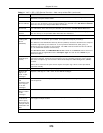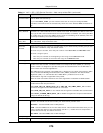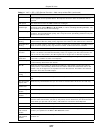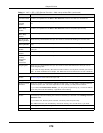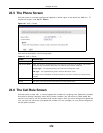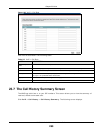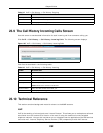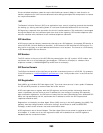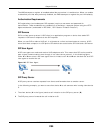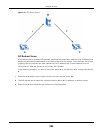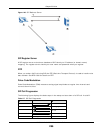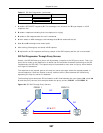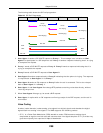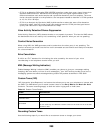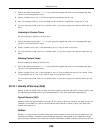
Chapter 23 Voice
VMG5313-B10A/-B30A Series User’s Guide
283
Circuit-switched telephone networks require 64 kilobits per second (Kbps) in each direction to
handle a telephone call. VoIP can use advanced voice coding techniques with compression to reduce
the required bandwidth.
SIP
The Session Initiation Protocol (SIP) is an application-layer control (signaling) protocol that handles
the setting up, altering and tearing down of voice and multimedia sessions over the Internet.
SIP signaling is separate from the media for which it handles sessions. The media that is exchanged
during the session can use a different path from that of the signaling. SIP handles telephone calls
and can interface with traditional circuit-switched telephone networks.
SIP Identities
A SIP account uses an identity (sometimes referred to as a SIP address). A complete SIP identity is
called a SIP URI (Uniform Resource Identifier). A SIP account's URI identifies the SIP account in a
way similar to the way an e-mail address identifies an e-mail account. The format of a SIP identity
is SIP-Number@SIP-Service-Domain.
SIP Number
The SIP number is the part of the SIP URI that comes before the “@” symbol. A SIP number can
use letters like in an e-mail address (johndoe@your-ITSP.com for example) or numbers like a
telephone number (1122334455@VoIP-provider.com for example).
SIP Service Domain
The SIP service domain of the VoIP service provider is the domain name in a SIP URI. For example,
if the SIP address is 1122334455@VoIP-provider.com
, then “VoIP-provider.com” is the SIP service
domain.
SIP Registration
Each VMG is an individual SIP User Agent (UA). To provide voice service, it has a public IP address
for SIP and RTP protocols to communicate with other servers.
A SIP user agent has to register with the SIP registrar and must provide information about the
users it represents, as well as its current IP address (for the routing of incoming SIP requests).
After successful registration, the SIP server knows that the users (identified by their dedicated SIP
URIs) are represented by the UA, and knows the IP address to which the SIP requests and
responses should be sent.
Registration is initiated by the User Agent Client (UAC) running in the VoIP gateway (the VMG). The
gateway must be configured with information letting it know where to send the REGISTER
message, as well as the relevant user and authorization data.
A SIP registration has a limited lifespan. The User Agent Client must renew its registration within
this lifespan. If it does not do so, the registration data will be deleted from the SIP registrar's
database and the connection broken.



